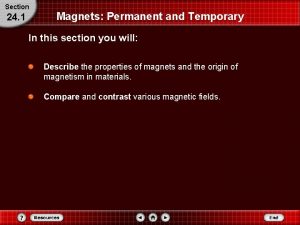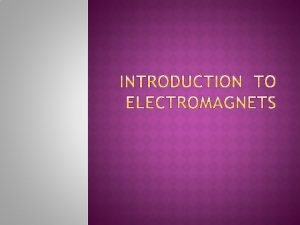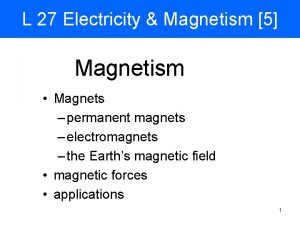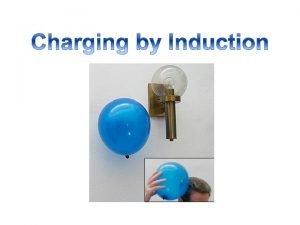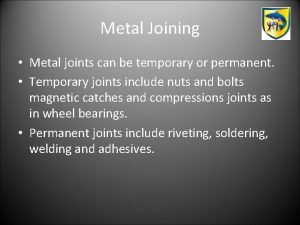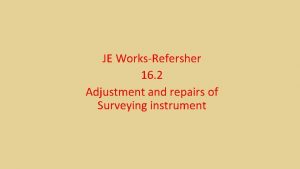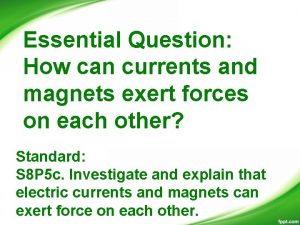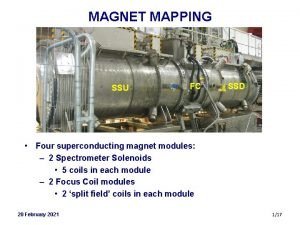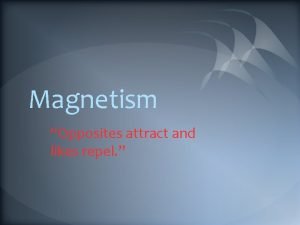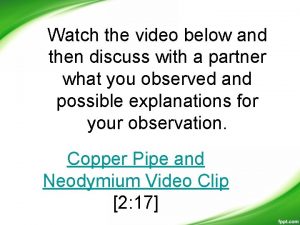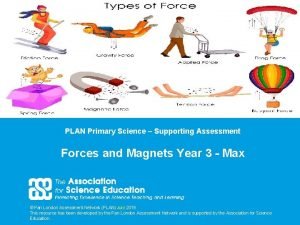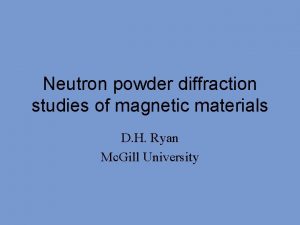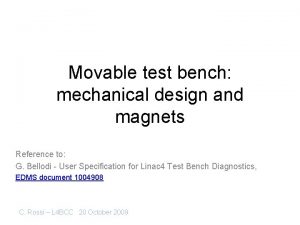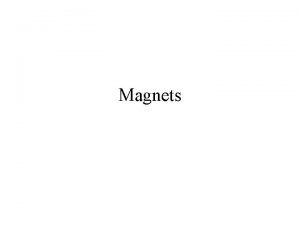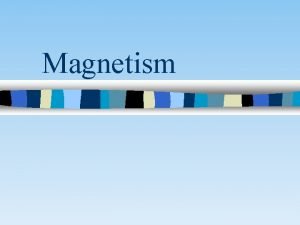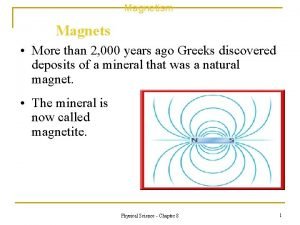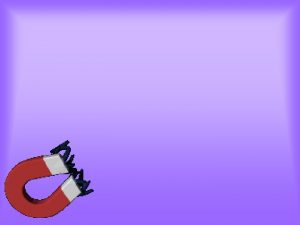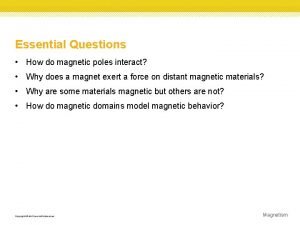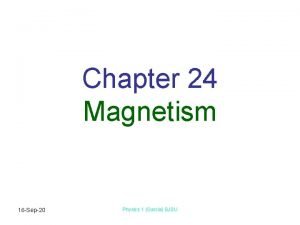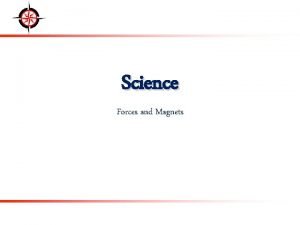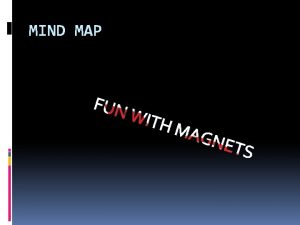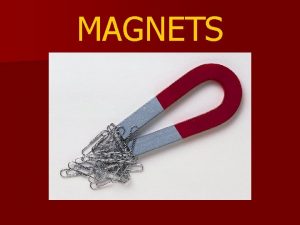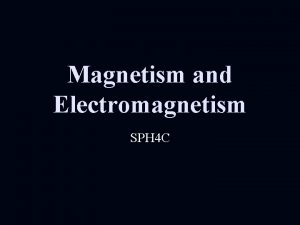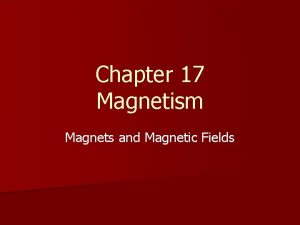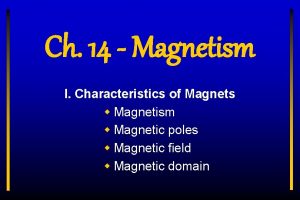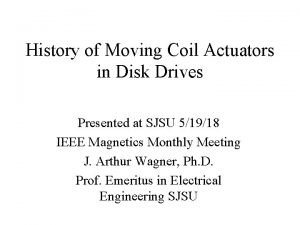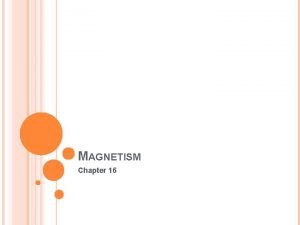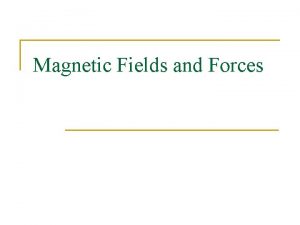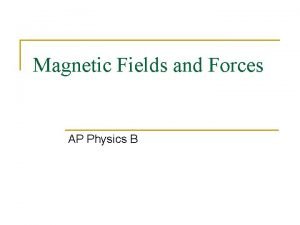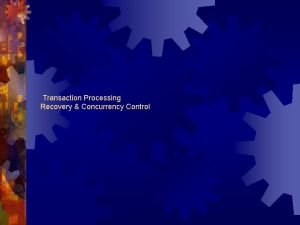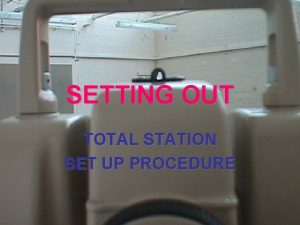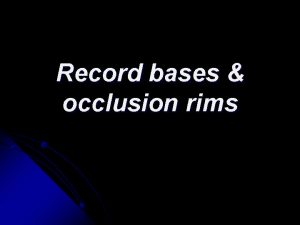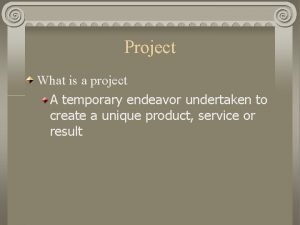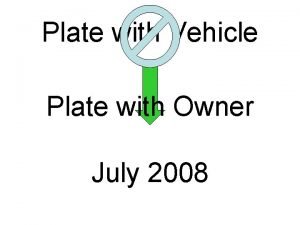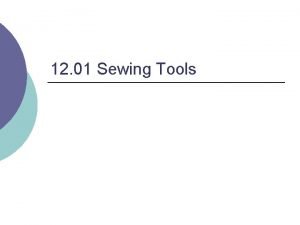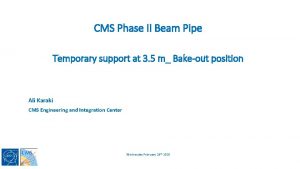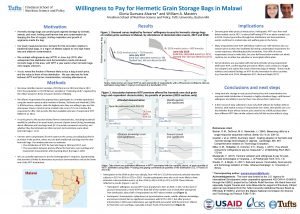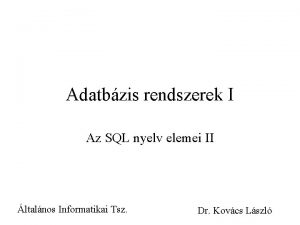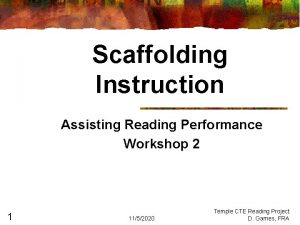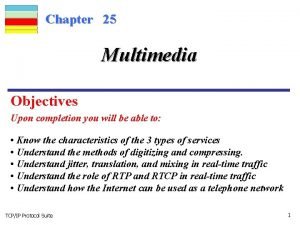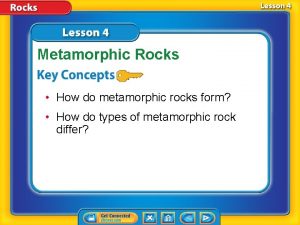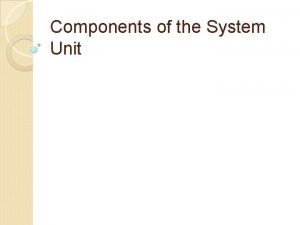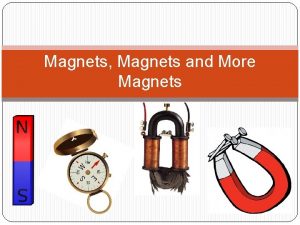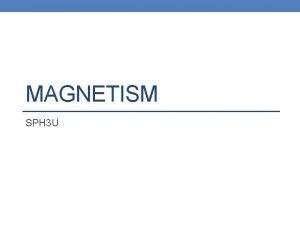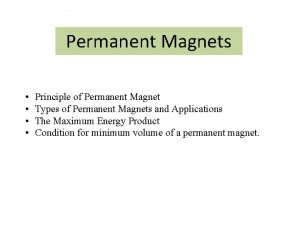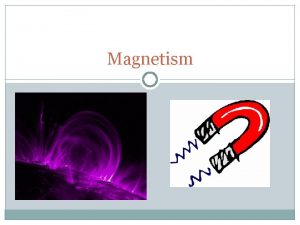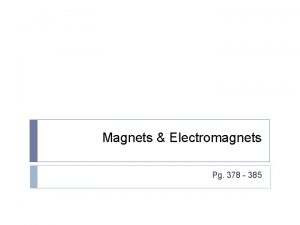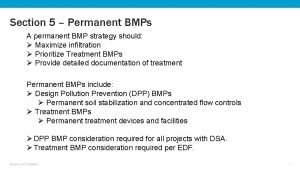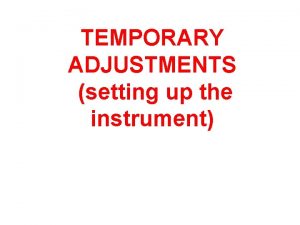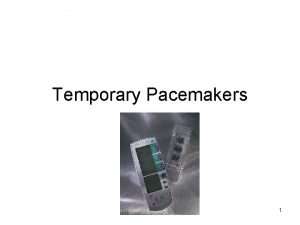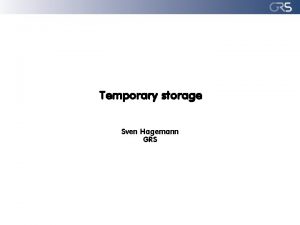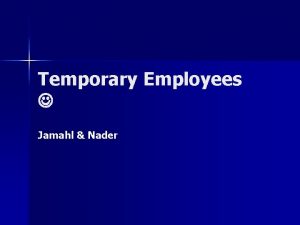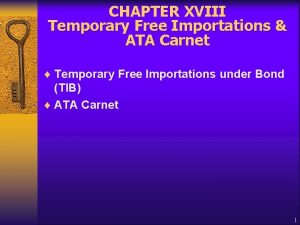Section 24 1 Magnets Permanent and Temporary In



































































































- Slides: 99

Section 24. 1 Magnets: Permanent and Temporary In this section you will: Describe the properties of magnets and the origin of magnetism in materials. Compare and contrast various magnetic fields.

Section 24. 1 Magnets: Permanent and Temporary General Properties of Magnets You should have found that the magnet lined up in a northsouth direction. Mark the end that points to the north with the letter N for reference.

Section 24. 1 Magnets: Permanent and Temporary General Properties of Magnets From this simple experiment, you can conclude that a magnet is polarized. A magnet is said to be polarized when it has two distinct and opposite ends. One of the poles is the north-seeking pole; the other is the south -seeking pole.

Section 24. 1 Magnets: Permanent and Temporary General Properties of Magnets Suspend another magnet to determine the north end, and mark it as you did with the first magnet. While one magnet is suspended, observe the interaction of the two magnets by bringing the other magnet near.

Section 24. 1 Magnets: Permanent and Temporary General Properties of Magnets You should have observed that the two north poles repelled each other, as did the two south poles. However, the north pole of one magnet should have attracted the south pole of the other magnet. Like poles repel; unlike poles attract. Magnets always have two opposite magnetic poles. If you break a magnet in half, you create two smaller magnets, and each will have two poles. Scientists have tried to break magnets into separate north and south poles, called monopoles, but no one has succeeded, not even on the microscopic level.

Section 24. 1 Magnets: Permanent and Temporary General Properties of Magnets Knowing that magnets always orient themselves in a north-south direction, it may occur to you that Earth itself is a giant magnet. Because opposite poles attract and the north pole of a compass magnet points north, the south pole of the Earth-magnet must be near Earth’s geographic north pole.

Section 24. 1 Magnets: Permanent and Temporary General Properties of Magnets attract things besides other magnets, such as nails, tacks, paper clips, and many other metal objects. Unlike the interaction between two magnets, however, either end of a magnet will attract either end of a piece of metal. How can you explain this behavior? First, you can touch a magnet to a nail and then touch the nail to smaller metal pieces. The nail itself becomes a magnet, as shown in the figure at right.

Section 24. 1 Magnets: Permanent and Temporary General Properties of Magnets The magnet causes the nail to become polarized. The direction of polarization of the nail depends on the polarization of the magnet. If you pull away the magnet, the nail loses some of its magnetization and will no longer exhibit as much attraction for other metal objects.

Section 24. 1 Magnets: Permanent and Temporary General Properties of Magnets When a magnet touches a piece of soft iron (iron with a low carbon content) in place of a nail, you will notice that the iron loses all of its attraction for the other metal objects when the magnet is pulled away. This is because soft iron is a temporary magnet. A nail has other material in it to make it harder and allows it to retain some of its magnetism when a permanent magnet is pulled away.

Section 24. 1 Magnets: Permanent and Temporary General Properties of Magnets The magnetism of permanent magnets is produced in the same way in which you created the magnetism of the nail. Because of the microscopic structure of the magnet material, the induced magnetism becomes permanent. Many permanent magnets are made of an iron alloy called ALNICO V, that contains a mix of aluminum, nickel, and cobalt. A variety of rare earth elements, such as neodymium and gadolinium, produce permanent magnets that are extremely strong for their size.

Section 24. 1 Magnets: Permanent and Temporary Magnetic Fields Around Permanent Magnets When you experimented with two magnets, you noticed that the forces between magnets, both attraction and repulsion, occur not only when the magnets touch each other, but also when they are held apart. In the same way that long-range electric and gravitational forces can be described by electric and gravitational fields, magnetic forces can be described by the existence of fields around magnets. These magnetic fields are vector quantities that exist in a region in space where a magnetic force occurs.

Section 24. 1 Magnets: Permanent and Temporary Magnetic Fields Around Permanent Magnets The presence of a magnetic field around a magnet can be shown using iron filings. Each long, thin, iron filing becomes a small magnet by induction. Just like a tiny compass needle, the iron filing rotates until it is parallel to the magnetic field. The adjacent figure shows filings in a glycerol solution surrounding a bar magnet. The three-dimensional shape of the field is visible.

Section 24. 1 Magnets: Permanent and Temporary Magnetic Fields Around Permanent Magnets In the adjoining figure, the filings make up a two-dimensional plot of the field, which can help you visualize magnetic field lines.

Section 24. 1 Magnets: Permanent and Temporary Magnetic Fields Around Permanent Magnets Note that magnetic field lines, like electric field lines, are imaginary. They are used to help us visualize a field, and they also provide a measure of the strength of the magnetic field. The number of magnetic field lines passing through a surface is called the magnetic flux. The flux per unit area is proportional to the strength of the magnetic field. The magnetic flux is most concentrated at the poles; thus, this is where the magnetic field strength is the greatest.

Section 24. 1 Magnets: Permanent and Temporary Magnetic Fields Around Permanent Magnets The direction of a magnetic field line is defined as the direction in which the north pole of a compass points when it is placed in the magnetic field. Outside the magnet, the field lines emerge from the magnet at its north pole and enter the magnet at its south pole, as illustrated below.

Section 24. 1 Magnets: Permanent and Temporary Magnetic Fields Around Permanent Magnets Inside the magnet, there are no isolated poles on which field lines can start or stop, so magnetic field lines always travel inside the magnet from the south pole to the north pole to form closed loops.

Section 24. 1 Magnets: Permanent and Temporary Magnetic Fields Around Permanent Magnets What kinds of magnetic fields are produced by pairs of bar magnets? You can visualize these fields by placing two magnets on a sheet of paper, and then sprinkling the paper with iron filings. The figure below shows the field lines between two like poles.

Section 24. 1 Magnets: Permanent and Temporary Magnetic Fields Around Permanent Magnets In contrast, two unlike poles (north and south) placed close together produce the pattern shown in the figure below. The filings show that the field lines between two unlike poles run directly from one magnet to the other.

Section 24. 1 Magnets: Permanent and Temporary Magnetic Fields Around Permanent Magnets Magnetic fields exert forces on other magnets. The field produced by the north pole of one magnet pushes the north pole of a second magnet away in the direction of the field line. The force exerted by the same field on the south pole of the second magnet is attractive in a direction opposite the field lines. The second magnet attempts to line up with the field, just like a compass needle.

Section 24. 1 Magnets: Permanent and Temporary Magnetic Fields Around Permanent Magnets When a sample made of iron, cobalt, or nickel is placed in the magnetic field of a permanent magnet, the field lines become concentrated within the sample. Lines leaving the north pole of the magnet enter one end of the sample, pass through it, and leave the other end. Thus, the end of the sample closest to the magnet’s north pole becomes the sample’s south pole, and the sample is attracted to the magnet.

Section 24. 1 Magnets: Permanent and Temporary Electromagnetism In 1820, Danish physicist Hans Christian Oersted was experimenting with electric currents in wires. Oersted laid a wire across the top of a small compass and connected the ends of the wire to complete an electrical circuit, as shown. He had expected the needle to point toward the wire or in the same direction as the current in the wire.

Section 24. 1 Magnets: Permanent and Temporary Electromagnetism Instead, Oersted was amazed to see that the needle rotated until it pointed perpendicular to the wire, as shown in the figure at right. The forces on the compass magnet’s poles were perpendicular to the direction of current in the wire. Oersted also found that when there was no current in the wire, no magnetic forces existed.

Section 24. 1 Magnets: Permanent and Temporary Electromagnetism If a compass needle turns when placed near a wire carrying an electric current, it must be the result of a magnetic field created by the current. You can easily show the magnetic field around a current-carrying wire by placing a wire vertically through a horizontal piece of cardboard on which iron filings are sprinkled.

Section 24. 1 Magnets: Permanent and Temporary Electromagnetism When there is current through the wire, the filings will form a pattern of concentric circles, around the wire. The circular lines indicate that magnetic field lines around current-carrying wires form closed loops in the same way that field lines about permanent magnets form closed loops. The strength of the magnetic field around a long, straight wire is proportional to the current in the wire.

Section 24. 1 Magnets: Permanent and Temporary Electromagnetism The strength of the field also varies inversely with the distance from the wire. A compass shows the direction of the field lines. If you reverse the direction of the current, the compass needle also reverses its direction, as shown in the figure at right.

Section 24. 1 Magnets: Permanent and Temporary A Microscopic Picture of Magnetic Materials Recall that when you put a piece of iron, nickel, or cobalt next to a magnet, the element also becomes magnetic, and it develops north and south poles. The magnetism, however, is only temporary. The creation of this temporary polarity depends on the direction of the external field. When you take away the external field, the element loses its magnetism. The three elements—iron, nickel, and cobalt—behave like electromagnets in many ways. They have a property called ferromagnetism.

Section 24. 1 Magnets: Permanent and Temporary A Microscopic Picture of Magnetic Materials In the early nineteenth century, French scientist André-Marie Ampère knew that the magnetic effects of an electromagnet are the result of electric current through its loops. He proposed a theory of magnetism in iron to explain this behavior. Ampère reasoned that the effects of a bar magnet must result from tiny loops of current within the bar. Although the details of Ampère’s reasoning were wrong, his basic idea was correct.

Section 24. 1 Magnets: Permanent and Temporary A Microscopic Picture of Magnetic Materials Each electron in an atom acts like a tiny electromagnet. When the magnetic fields of the electrons in a group of neighboring atoms are all aligned in the same direction, the group is called a domain. Although they may contain 1020 individual atoms, domains are still very small—usually from 10 to 1000 microns. Thus, even a small sample of iron contains a huge number of domains.

Section 24. 1 Magnets: Permanent and Temporary A Microscopic Picture of Magnetic Materials When a piece of iron is not in a magnetic field, the domains point in random directions, and their magnetic fields cancel one another out. If, however, a piece of iron is placed in a magnetic field, the domains tend to align with the external field.

Section 24. 1 Magnets: Permanent and Temporary A Microscopic Picture of Magnetic Materials In the case of a temporary magnet, after the external field is removed, the domains return to their random arrangement. In a permanent magnet, the iron has been alloyed with other substances to keep the domains aligned after the external magnetic field is removed.

Section 24. 1 Magnets: Permanent and Temporary A Microscopic Picture of Magnetic Materials Electromagnets make up the recording heads of audio cassette and videotape recorders. Recorders create electrical signals that represent the sounds or pictures being recorded. The electric signals produce currents in the recording head that create magnetic fields. When magnetic recording tape, which has many tiny bits of magnetic material bonded to thin plastic, passes over the recording head, the domains of the bits are aligned by the magnetic fields of the head.

Section 24. 1 Magnets: Permanent and Temporary A Microscopic Picture of Magnetic Materials The directions of the domains’ alignments depend on the direction of the current in the head and become a magnetic record of the sounds or pictures being recorded. The magnetic material on the tape allows the domains to keep their alignments until a strong enough magnetic field is applied to change them again. On a playback of the tape, the signal, produced by currents generated as the head passes over the magnetic particles, goes to an amplifier and a pair of loudspeakers or earphones. When a previously recorded tape is used to record new sounds, an erase head produces a rapidly alternating magnetic field that randomizes the directions of the domains on the tape.

Section 24. 1 Magnets: Permanent and Temporary A Microscopic Picture of Magnetic Materials Rocks containing iron have recorded the history of the varying directions of Earth’s magnetic field. Rocks on the seafloor were produced when molten rock poured out of cracks in the bottom of the oceans. As they cooled, the rocks were magnetized in the direction of Earth’s field at the time. As a result of seafloor spreading, the rocks farther from the cracks are older than those near the cracks.

Section 24. 1 Magnets: Permanent and Temporary A Microscopic Picture of Magnetic Materials Scientists who first examined seafloor rocks were surprised to find that the direction of the magnetization in different rocks varied. They concluded from their data that the north and south magnetic poles of Earth have exchanged places many times in Earth’s history. The origin of Earth’s magnetic field is not well understood. How this field might reverse direction is even more of a mystery.

Section Check 24. 1 Question 1 What happens when the North Pole of one magnet is brought near the South Pole of another magnet? A. The magnets attract each other. B. There will be no effect. C. The magnets repel each other. D. The magnets partially attract and partially repel each other.

Section 24. 1 Section Check Answer 1 Answer: A Reason: When the North Pole of one magnet is brought near the South Pole of another magnet, the two magnets will attract each other, as unlike poles attract each other. Also, if the North Pole of one magnet is brought near the North Pole of another magnet, the two magnets will repel each other, as like poles repel each other.

Section Check 24. 1 Question 2 What is the direction of a magnetic field line (imaginary line) of a bar magnet? A. Outside the magnet, magnetic field lines emerge from the magnet at its North Pole and enter the magnet at its South Pole; they do not travel inside the magnet. B. Outside the magnet, magnetic field lines emerge from the magnet at its South Pole and enter the magnet at its North Pole; they do not travel inside the magnet. Continued

Section Check 24. 1 Question 2 Continued What is the direction of a magnetic field line (imaginary line) of a bar magnet? C. Outside the magnet, magnetic field lines emerge from the South Pole and enter the magnet at its North Pole. Inside the magnet, the magnetic field lines travel from the North Pole to the South Pole. D. Outside the magnet, magnetic field lines emerge from the North Pole and enter the magnet at its South Pole. Inside the magnet, the magnetic field lines travel from the South Pole to the North Pole.

Section 24. 1 Section Check Answer 2 Answer: D Reason: The direction of a magnetic field line is defined as the direction in which the North Pole of a compass points when it is placed in the magnetic field. Outside the magnet, the field lines emerge from the magnet at its North Pole and enter the magnet at its South Pole. What happens inside the magnet? There are no isolated poles on which held lines can start or stop, so magnetic field lines always travel inside the magnet from the South Pole to the North Pole to form closed loops.

Section Check 24. 1 Question 3 What will happen if you lay a wire across the top of a small compass and connect the ends of a wire to complete an electrical circuit? A. The needle of the compass will point in the same direction of the current in the wire. B. The needle of the compass will point in the opposite direction of the current in the wire. C. The needle of the compass will point in the direction perpendicular to the direction of the current in the wire. D. The needle of the compass will point in the direction making an angle of 45° with the direction of the current in the wire.

Section 24. 1 Section Check Answer 3 Answer: C Reason: Oersted, while experimenting with electric currents in wires, laid a wire across the top of a small compass and connected the ends of the wire to complete an electrical circuit. He expected the needle to point toward the wire or in the same direction as the current in the wire. Instead, he was amazed to see that the needle rotated until it pointed perpendicular to the wire. The forces on the compass magnet’s poles were perpendicular to the direction of the current in the wire. Oersted also found that when there was no current in the wire, no magnetic forces existed.

Section 24. 2 Forces Caused by Magnetic Fields In this section you will: Relate magnetic induction to the direction of the force on a current-carrying wire in a magnetic field. Solve problems involving magnetic field strength and the forces on current-carrying wires, and on moving, charged particles in magnetic fields. Describe the design and operation of an electric motor.

Section 24. 2 Forces Caused by Magnetic Fields Forces on Currents in Magnetic Fields Because a magnetic field exerts forces on permanent magnets, Ampère hypothesized that there is also a force on a currentcarrying wire when it is placed in a magnetic field. The force on a wire in a magnetic field can be demonstrated using the arrangement shown below.

Section 24. 2 Forces Caused by Magnetic Fields Forces on Currents in Magnetic Fields When there is a current in the wire, a force is exerted on the wire. Depending on the direction of the current, the force on the wire can push it down, as shown in the figure below.

Section 24. 2 Forces Caused by Magnetic Fields Forces on Currents in Magnetic Fields The force on the wire can also pull it up, as shown in the figure below. Michael Faraday discovered that the force on the wire is at right angles to both the direction of the magnetic field and the direction of the current.

Section 24. 2 Forces Caused by Magnetic Fields Forces on Currents in Magnetic Fields Soon after Oersted announced his discovery that the direction of the magnetic field in a wire is perpendicular to the flow of electric current in the wire, Ampère was able to demonstrate the forces that current-carrying wires exert on each other. The adjoining animation shows the direction of the magnetic field around each of the current-carrying wires, which is determined by the first right-hand rule.

Section 24. 2 Forces Caused by Magnetic Fields Forces on Currents in Magnetic Fields By applying the third right-hand rule to either wire, you can show why the wires attract each other. The animation demonstrates the opposite situation. When currents are in opposite directions, the wires have a repulsive force between them.

Section 24. 2 Forces Caused by Magnetic Fields Forces on Currents in Magnetic Fields It is possible to determine the force of magnetism exerted on a current-carrying wire passing through a magnetic field at right angles to the wire. Experiments show that the magnitude of the force, F, on the wire, is proportional to the strength of the field, B, the current, I, in the wire, and the length, S, of the wire in the magnetic field. Force on a Current-Carrying Wire in a Magnetic Field The force on a current-carrying wire in a magnetic field is equal to the product of magnetic field strength, the current, and the length of the wire.

Section 24. 2 Forces Caused by Magnetic Fields Forces on Currents in Magnetic Fields The strength of a magnetic field, B, is measured in teslas, T. 1 T is equivalent to 1 N/Am. Note that if the wire is not perpendicular to the magnetic field, a factor of sin θ is introduced in the above equation, resulting in F = ILB sin θ. As the wire becomes parallel to the magnetic field, the angle θ becomes zero, and the force is reduced to zero. When θ = 90°, the equation is again F = ILB.

Section 24. 2 Forces Caused by Magnetic Fields Loudspeakers One use of the force on a current-carrying wire in a magnetic field is in a loudspeaker. A loudspeaker changes electric energy to sound energy using a coil of fine wire mounted on a paper cone and placed in a magnetic field. The amplifier driving the loudspeaker sends a current through the coil.

Section 24. 2 Forces Caused by Magnetic Fields Loudspeakers The current changes direction between 20 and 20, 000 times each second, depending on the pitch of the tone it represents. A force exerted on the coil, because it is in a magnetic field, pushes the coil either into or out of the field, depending on the direction of the current. The motion of the coil causes the cone to vibrate, thereby creating sound waves in the air.

Section 24. 2 Forces Caused by Magnetic Fields Calculate the Strength of a Magnetic Field A straight wire carrying a 5. 0 -A current is in a uniform magnetic field oriented at right angles to the wire. When 0. 10 m of the wire is in the field, the force on the wire is 0. 20 N. What is the strength of the magnetic field, B?

Section 24. 2 Forces Caused by Magnetic Fields Calculate the Strength of a Magnetic Field Step 1: Analyze and Sketch the Problem

Section 24. 2 Forces Caused by Magnetic Fields Calculate the Strength of a Magnetic Field Sketch the wire and show the direction of the current with an arrow, the magnetic field lines labeled B, and the force on the wire, F.

Section 24. 2 Forces Caused by Magnetic Fields Calculate the Strength of a Magnetic Field Determine the direction of the force using the third right-hand rule. The field, wire, and force are all at right angles.

Section 24. 2 Forces Caused by Magnetic Fields Calculate the Strength of a Magnetic Field Identify the known and unknown variables. Known: Unknown: I = 5. 0 A B=? L = 0. 10 m F = 0. 20 N

Section 24. 2 Forces Caused by Magnetic Fields Calculate the Strength of a Magnetic Field Step 2: Solve for the Unknown

Section 24. 2 Forces Caused by Magnetic Fields Calculate the Strength of a Magnetic Field B is uniform and because B and I are perpendicular to each other, F = ILB.

Section 24. 2 Forces Caused by Magnetic Fields Calculate the Strength of a Magnetic Field Solve for B.

Section 24. 2 Forces Caused by Magnetic Fields Calculate the Strength of a Magnetic Field Substitute F = 0. 20 N, I = 5. 0 A, L = 0. 10 m B is 0. 40 T from left to right and perpendicular to I and F.

Section 24. 2 Forces Caused by Magnetic Fields Calculate the Strength of a Magnetic Field Step 3: Evaluate the Answer

Section 24. 2 Forces Caused by Magnetic Fields Calculate the Strength of a Magnetic Field Are the units correct? The answer is in teslas, the correct unit for a magnetic field. Is the magnitude realistic? The current and the length make the magnetic field fairly large, which is realistic.

Section 24. 2 Forces Caused by Magnetic Fields Calculate the Strength of a Magnetic Field The steps covered were: Step 1: Analyze and Sketch the Problem – Sketch the wire and show the direction of the current with an arrow, the magnetic field lines labeled B, and the force on the wire, F. – Determine the direction of the force using the third righthand rule. The field, wire, and force are all at right angles.

Section 24. 2 Forces Caused by Magnetic Fields Calculate the Strength of a Magnetic Field The steps covered were: Step 2: Solve for the Unknown – Solve for B. Step 3: Evaluate the Answer

Section 24. 2 Forces Caused by Magnetic Fields Galvanometers The forces exerted on a loop of wire in a magnetic field can be used to measure current. If a small loop of current-carrying wire is placed in the strong magnetic field of a permanent magnet, as in the figure below, it is possible to measure very small currents.

Section 24. 2 Forces Caused by Magnetic Fields Galvanometers The current passing through the loop goes in one end of the loop and out the other end. Applying the third right-hand rule to each side of the loop, note that one side of the loop is forced down, while the other side of the loop is forced up.

Section 24. 2 Forces Caused by Magnetic Fields Galvanometers The resulting torque rotates the loop, and the magnitude of the torque acting on the loop is proportional to the magnitude of the current. This principle is used in a galvanometer. A galvanometer is a device used to measure very small currents, and therefore, it can be used as a voltmeter or an ammeter. A small spring in the galvanometer exerts a torque that opposes the torque that results from the flow of current through the wire loop; thus, the amount of rotation is proportional to the current.

Section 24. 2 Forces Caused by Magnetic Fields Galvanometers The meter is calibrated by finding out how much the coil turns when a known current is sent through it, as shown in the figure. The galvanometer can then be used to measure unknown currents. Many galvanometers produce fullscale deflections with as little as 50 µA (50× 10− 6 A) of current.

Section 24. 2 Forces Caused by Magnetic Fields Galvanometers The resistance of the coil of wire in a sensitive galvanometer is about 1000 Ω. To measure larger currents, a galvanometer can be converted into an ammeter by placing a resistor with resistance smaller than the galvanometer in parallel with the meter.

Section 24. 2 Forces Caused by Magnetic Fields Galvanometers Most of the current, Is, passes through the resistor, called the shunt, because the current is inversely proportional to resistance; whereas only a few microamps, Im, flow through the galvanometer. The resistance of the shunt is chosen according to the desired deflection scale.

Section 24. 2 Forces Caused by Magnetic Fields Galvanometers A galvanometer also can be connected as a voltmeter. To make a voltmeter, a resistor, called the multiplier, is placed in series with the meter, as shown in the figure. The galvanometer measures the current through the multiplier. The current is represented by I = V/R, where V is the voltage across the voltmeter and R is the effective resistance of the galvanometer and the multiplier resistor.

Section 24. 2 Forces Caused by Magnetic Fields Galvanometers The wire coil in an electric motor is called the armature. The armature is made of many loops mounted on a shaft or axle. The total force acting on the armature is proportional to n. ILB, where n is the total number of turns on the armature, B is the strength of the magnetic field, I is the current, and L is the length of wire in each turn that moves through the magnetic field. The magnetic field is produced either by permanent magnets or by an electromagnet, called a field coil. The torque on the armature, and, as a result, the speed of the motor, is controlled by varying the current through the motor.

Section 24. 2 Forces Caused by Magnetic Fields The Force on a Single Charged Particle Charged particles do not have to be confined to a wire, but can move across any region as long as the air has been removed to prevent collisions with air particles. A picture tube, also called a cathode-ray tube, in a computer monitor or television set uses electrons deflected by magnetic fields to form the pictures on the screen, as illustrated in the adjoining figure.

Section 24. 2 Forces Caused by Magnetic Fields The Force on a Single Charged Particle Electric fields pull electrons off atoms in the negative electrode, or cathode. Other electric fields gather, accelerate, and focus the electrons into a narrow beam. Magnetic fields control the motion of the beam back-and-forth and up-and-down across the screen. The screen is coated with a phosphor that glows when it is struck by the electrons, thereby producing the picture.

Section 24. 2 Forces Caused by Magnetic Fields The Force on a Single Charged Particle The force produced by a magnetic field on a single electron depends on the velocity of the electron, the strength of the field, and the angle between directions of the velocity and the field. Consider a single electron moving in a wire of length L. The electron is moving perpendicular to the magnetic field. The current, I, is equal to the charge per unit time entering the wire, I = q/t. In this case, q is the charge of the electron and t is the time it takes to move the distance, L.

Section 24. 2 Forces Caused by Magnetic Fields The Force on a Single Charged Particle The time required for a particle with speed v to travel distance L is found by using the equation of motion, d = vt, or, in this case, t = L/v. As a result, the equation for the current, I = q/t, can be replaced by I = qv/L. Therefore, the force on a single electron moving perpendicular to a magnetic field of strength B can be found. Force of a Magnetic Field on a Charged, Moving Particle

Section 24. 2 Forces Caused by Magnetic Fields The Force on a Single Charged Particle The force on a particle moving in a magnetic field is equal to the product of the field strength, the charge of the particle, and its velocity. The particle’s charge is measured in coulombs, C, its velocity in meters per second, m/s, and the strength of the magnetic field in teslas, T. The direction of the force is perpendicular to both the velocity of the particle and the magnetic field. The direction given by the third right-hand rule is for positively charged particles. For electrons, the force is in the opposite direction.

Section 24. 2 Forces Caused by Magnetic Fields Force on a Charged Particle in a Magnetic Field A beam of electrons travels at 3. 0× 106 m/s through a uniform magnetic field of 4. 0× 10− 2 T at right angles to the field. How strong is the force acting on each electron?

Section 24. 2 Forces Caused by Magnetic Fields Force on a Charged Particle in a Magnetic Field Step 1: Analyze and Sketch the Problem

Section 24. 2 Forces Caused by Magnetic Fields Force on a Charged Particle in a Magnetic Field Draw the beam of electrons and its direction of motion; the magnetic field of lines, labeled B; and the force on the electron beam, F. Remember that the force is opposite the force given by the third right -hand rule because of the electron’s negative charge.

Section 24. 2 Forces Caused by Magnetic Fields Force on a Charged Particle in a Magnetic Field Identify the known and unknown variables. Known: Unknown: v = 3. 0× 106 m/s F=? B = 4. 0× 10− 2 T q = − 1. 60× 10− 19 C

Section 24. 2 Forces Caused by Magnetic Fields Force on a Charged Particle in a Magnetic Field Step 2: Solve for the Unknown

Section 24. 2 Forces Caused by Magnetic Fields Force on a Charged Particle in a Magnetic Field F = qv. B Substitute q = − 1. 60× 10− 19 C, v = 3. 0× 106 m/s, B = 4. 0× 10− 2 T

Section 24. 2 Forces Caused by Magnetic Fields Force on a Charged Particle in a Magnetic Field Step 3: Evaluate the Answer

Section 24. 2 Forces Caused by Magnetic Fields Force on a Charged Particle in a Magnetic Field Are the units correct? T = N/(A·m), and A = C/s; so T = N·s/(C·m). Thus, (T·C·m)/s = N, the unit force. Does the direction make sense? Use third right-hand rule to verify that the directions of the forces are correct, recalling that the force on the electron is opposite the force given by the third right-hand rule. Is the magnitude realistic? Forces on electrons and protons are always small fractions of a newton.

Section 24. 2 Forces Caused by Magnetic Fields Force on a Charged Particle in a Magnetic Field The steps covered were: Step 1: Analyze and Sketch the Problem – Draw the beam of electrons and its direction of motion; the magnetic field of lines, labeled B; and the force on the electron beam, F. Step 2: Solve for the Unknown Step 3: Evaluate the Answer

Section 24. 2 Forces Caused by Magnetic Fields Storing Information with Magnetic Media Data and software commands for computers are processed digitally in bits. Each bit is identified as either a 0 or a 1. How are these bits stored? The surface of a computer storage disk is covered with an even distribution of magnetic particles within a film. The direction of the particles’ domains changes in response to a magnetic field. During recording onto the disk, current is routed to the disk drive’s read/write head, which is an electromagnet composed of a wire-wrapped iron core.

Section 24. 2 Forces Caused by Magnetic Fields Storing Information with Magnetic Media The current through the wire induces a magnetic field in the core. When the read/write head passes over the spinning storage disk, as in the figure below, the domains of atoms in the magnetic film line up in bands.

Section 24. 2 Forces Caused by Magnetic Fields Storing Information with Magnetic Media The orientation of the domains depends on the direction of the current. Two bands code for one bit of information. Two bands magnetized with the poles oriented in the same direction represent 0. Two bands represent 1 with poles oriented in opposite directions. The recording current always reverses when the read/write head begins recording the next data bit.

Section 24. 2 Forces Caused by Magnetic Fields Storing Information with Magnetic Media To retrieve data, no current is sent to the read/write head. Rather, the magnetized bands in the disk induce current in the coil as the disk spins beneath the head. Changes in the direction of the induced current are sensed by the computer and interpreted as 0’s and 1’s.

Section Check 24. 2 Question 1 A current-carrying wire is kept in a magnetic field such that the direction of the flow of conventional current is perpendicular to the direction of the magnetic field. In which direction will the wire experience the force? A. In the direction of the magnetic field. B. In a direction opposite to the magnetic field. C. In a direction perpendicular to both the direction of the magnetic field and the direction of the conventional current. D. In a direction perpendicular to both the direction of the magnetic field and the direction opposite to the direction of the conventional current.

Section 24. 2 Section Check Answer 1 Answer: C Reason: The direction of the force on a current-carrying wire in a magnetic field can be found by using the third right-hand rule, which is a method to determine the direction of force acting on a current-carrying wire in a magnetic field. To use third right-hand rule, point the fingers of your right hand in the direction of the magnetic field, and point your thumb in the direction of the conventional (positive) current in the wire. The palm of your hand will be facing in the direction of the force acting on the wire.

Section Check 24. 2 Question 2 A wire that is 1. 00 -m long and carrying a current of 10. 0 A is perpendicular to a 0. 40 -T magnetic field. How strong is the force that acts on the wire? A. B. C. D.

Section Check 24. 2 Answer: A Reason: Force on a current-carrying wire in a magnetic field, F = ILB. The force on a current-carrying wire in a magnetic field is equal to the product of magnetic field strength, the current, and the length of the wire. In this case, the force that acts on the wire will be. F = ILB = (10. 0 A)(1. 00 m)(0. 40 T) Force is measured in Newton, N.

Section 24. 2 Section Check Question 3 How can a galvanometer be made into a voltmeter to measure voltage across a circuit?

Section 24. 2 Section Check Answer 3 A galvanometer is a device used to measure very small currents and, therefore, it can be used as a voltmeter or an ammeter. A galvanometer can be connected as a voltmeter. To make a voltmeter, a resistor called the multiplier is placed in series with the meter, as shown in the following figure. The galvanometer measures the current through the multiplier. Current is represented by I = V/R. Now suppose you want the needle of the voltmeter to move across the entire scale when 10 V is placed across it. The resistor is chosen so that at 10 V, the meter is deflected full-scale by the current through the meter and the resistor.

Chapter 24 Magnetic Fields End of Chapter

Section 24. 2 Forces Caused by Magnetic Fields Calculate the Strength of a Magnetic Field A straight wire carrying a 5. 0 -A current is in a uniform magnetic field oriented at right angles to the wire. When 0. 10 m of the wire is in the field, the force on the wire is 0. 20 N. What is the strength of the magnetic field, B? Click the Back button to return to original slide.

Section 24. 2 Forces Caused by Magnetic Fields Force on a Charged Particle in a Magnetic Field A beam of electrons travels at 3. 0× 106 m/s through a uniform magnetic field of 4. 0× 10− 2 T at right angles to the field. How strong is the force acting on each electron? Click the Back button to return to original slide.
 Temporary vs permanent magnets
Temporary vs permanent magnets Temporary vs permanent magnets
Temporary vs permanent magnets Scrap yard magnet how it works
Scrap yard magnet how it works What are magnets made of
What are magnets made of Define nursery in agriculture
Define nursery in agriculture Is riveting a permanent joint
Is riveting a permanent joint Pull factors of migration
Pull factors of migration How to charge an object permanently using induction
How to charge an object permanently using induction Temporary joining methods for metal
Temporary joining methods for metal Permanent adjustment of level
Permanent adjustment of level Permanent solution
Permanent solution Magnets and springs
Magnets and springs Properties and interactions of magnets
Properties and interactions of magnets Magnetism lesson outline answer key
Magnetism lesson outline answer key How do currents and magnets exert forces on each other
How do currents and magnets exert forces on each other Ssd and magnets
Ssd and magnets Opposites attract and likes repel
Opposites attract and likes repel Electromagnet in speakers
Electromagnet in speakers Attract repel
Attract repel Electromagnet
Electromagnet Magnets for year 3
Magnets for year 3 Why do magnets repel
Why do magnets repel Magnets for neutron diffraction
Magnets for neutron diffraction Amazing magnets
Amazing magnets Why do magnets repel
Why do magnets repel Gmx 800 magnetic fluid conditioner
Gmx 800 magnetic fluid conditioner Natural magnets examples
Natural magnets examples A single wire wrap into a cylindrical wire coil is called
A single wire wrap into a cylindrical wire coil is called Oh magnets electromagnet
Oh magnets electromagnet Magnets have invisible
Magnets have invisible How do magnetic poles interact
How do magnetic poles interact Mr garcia uses magnets
Mr garcia uses magnets Amazing magnets
Amazing magnets Fun with magnets class 6 mind map
Fun with magnets class 6 mind map What is a magnet
What is a magnet Amazing magnets
Amazing magnets Force exerted by magnetic field
Force exerted by magnetic field Characteristics of magnets
Characteristics of magnets Hard drive actuator motor magnets
Hard drive actuator motor magnets Sigmaphi magnets
Sigmaphi magnets Which diagram shows magnets that will attract each other?
Which diagram shows magnets that will attract each other? Horseshoe magnets home depot
Horseshoe magnets home depot What is magnets
What is magnets Magnetic force
Magnetic force Facts about magnets for kids
Facts about magnets for kids What are magnets
What are magnets Organizational magnets
Organizational magnets Immediate temporary care given to an ill or injured person
Immediate temporary care given to an ill or injured person Suppose two waves collide and the temporary
Suppose two waves collide and the temporary Living life from god's perspective
Living life from god's perspective What is the section
What is the section Section 1 work and machines section 2 describing energy
Section 1 work and machines section 2 describing energy Temporary behavior of atmosphere
Temporary behavior of atmosphere Temporary update problem in dbms
Temporary update problem in dbms Temporary adjustments total station
Temporary adjustments total station Temporary record base
Temporary record base Temporary endeavor
Temporary endeavor Create length and height in hair design
Create length and height in hair design South dakota sellers permit
South dakota sellers permit Water cycle
Water cycle A scratch-pad for temporary recall.
A scratch-pad for temporary recall. Possible levels of customer expectations
Possible levels of customer expectations Transitory service intensifiers
Transitory service intensifiers Milady chapter 22 review questions
Milady chapter 22 review questions Used to trim threads two handles same size
Used to trim threads two handles same size American legion financial assistance
American legion financial assistance Ddo template version 4
Ddo template version 4 Temporary pipe supports
Temporary pipe supports Nameless temporary object in c++
Nameless temporary object in c++ Marketable securities adalah
Marketable securities adalah Hermetic grain storage bags
Hermetic grain storage bags Kelebihan sediaan emulsi adalah
Kelebihan sediaan emulsi adalah Uses rigid metallic platters
Uses rigid metallic platters Sssc suspension list
Sssc suspension list Melena is a temporary stoppage of intestinal peristalsis.
Melena is a temporary stoppage of intestinal peristalsis. Temporary table oracle
Temporary table oracle Temporary grain storage
Temporary grain storage Temporary support
Temporary support Balancing in theodolite
Balancing in theodolite Reiteration method in surveying
Reiteration method in surveying Repetition method in theodolite surveying
Repetition method in theodolite surveying Closing entries in accounting
Closing entries in accounting Temporary service intensifiers
Temporary service intensifiers What is a preliminary strand test
What is a preliminary strand test Nnn temporary broadcast
Nnn temporary broadcast Temporary habits
Temporary habits Kristin bains
Kristin bains Temporal key
Temporal key Ri temporary caregiver insurance
Ri temporary caregiver insurance Rtp uses a temporary even-numbered
Rtp uses a temporary even-numbered Permanent mold casting advantages and disadvantages
Permanent mold casting advantages and disadvantages Advantages of permanent mould casting
Advantages of permanent mould casting Present simple for a permanent situation or fact
Present simple for a permanent situation or fact Permanent bending and folding of rocks without melting
Permanent bending and folding of rocks without melting The relatively permanent and limitless storehouse
The relatively permanent and limitless storehouse Memory chips storing permanent data and instructions
Memory chips storing permanent data and instructions Augustus built a permanent and professional ________.
Augustus built a permanent and professional ________. What line types are usually omitted from sectional views?
What line types are usually omitted from sectional views? Broken section view
Broken section view Section quick check chapter 10 section 1 meiosis answer key
Section quick check chapter 10 section 1 meiosis answer key
